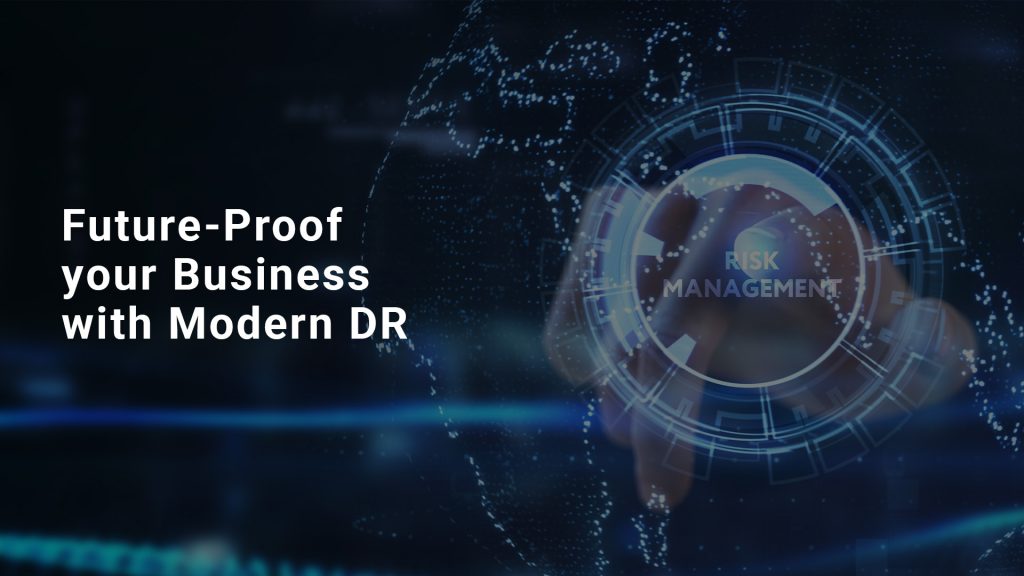France’s Grand Palais, Arcadian Ambulance Service, Security Service of Ukraine, AutoCanada, Halliburton, Pharma giant Cencora, ADT Alarm, US National Public Data, POLADA, Kootenai Health. Who are these companies, and what do they have in common? They were all victims of ransomware attacks in August 2024.
Now, imagine waking up to a world where your business grinds to a halt because of a disaster. Whether it’s a cyberattack, a cloud outage, or something as unpredictable as a natural disaster, it’s not just a momentary glitch—it’s the potential downfall of your operations. The question is: Can your current disaster recovery (DR) plan save your business?
The Changing Face of Disaster Recovery
Disaster recovery has come a long way from what it was two decades ago. Back in 1999, a 15-year-old hacker managed to infiltrate NASA and the U.S. Department of Defense. The attack brought down NASA’s and the Pentagon’s computer systems for three weeks, highlighting a glaring weakness: a lack of a cohesive disaster recovery plan. This was a wake-up call. The incident sparked discussions around cybersecurity, and although we saw dramatic change over the years, today, the stakes are even higher.
What we call a “disaster” has evolved. In the early 2000s, DR plans mainly focused on natural disasters. Companies prepared for floods, fires, and earthquakes by maintaining backups in offsite locations. Operations could move to these secondary, “cold” sites if the main office was down, albeit with some downtime.
Now, in the 2020s, the definition of disaster has expanded again. Today’s disasters include cyberattacks, hardware failures, and cloud provider outages. The rise of ransomware and other sophisticated attacks has changed the game. Cybercriminals can lock down your entire network, holding your data hostage until you pay a ransom. And, as organizations shift to the cloud, your cloud provider’s outage can take your business offline—sometimes for hours or even days.
This reality makes one thing clear: you need a modern disaster recovery strategy to fit the current threat landscape. Gone are the days when disaster recovery was just about having a backup for natural disasters. Today, DR must address more nuanced threats like ransomware, cloud service failures, and even employee errors.
So, what can be done to address these challenges? The answer lies in modernizing your disaster recovery plan to fit the current threat landscape. But what does modernizing your DR plan actually look like? Let’s explore.
Why Modern Disaster Recovery Demands Cloud Readiness
As more businesses rely on cloud services, your DR plan has to adapt. Cloud providers like Amazon Web Services (AWS), Microsoft Azure, and Google Cloud are now critical to day-to-day operations. But as reliable as they may seem, even these giants can suffer outages. When AWS went down last year, countless businesses around the world were affected.
This brings us to a critical point: if your entire operation depends on a single cloud provider, you’re exposed to a significant risk—a single point of failure (SPOF). Your cloud provider’s failure, no matter how rare, can cause a massive disruption to your business.
That’s why businesses are increasingly looking at Disaster Recovery-as-a-Service (DRaaS) and multi-cloud strategies. DRaaS is a cloud-based service model that allows businesses to back up their data and IT infrastructure in a third-party cloud environment. Using multiple cloud providers, you can distribute your critical workloads and ensure that your systems remain operational even if one provider experiences an outage. With DRaaS, you don’t just get data recovery; you get replication, failover, and the peace of mind that your systems are protected.
The Trifecta of Modern DR: Mitigating Cyber Threats, Ensuring Compliance, and Reducing Downtime
When we think about disaster recovery today, three main factors come into play: mitigating cyber threats, ensuring compliance, and reducing downtime.
1. Mitigating Cyber Threats
The biggest threat to organizations today is cyberattacks, particularly ransomware. According to a recent report, 75% of businesses experienced at least one ransomware attack in 2023. These attacks can cripple businesses by encrypting critical data and demanding payment for its release.
But you can reduce your exposure to these attacks by using DRaaS, which offers immutable backups. Immutable backups are copies of data that cannot be changed or deleted, providing a secure and reliable way to recover your data without paying a ransom. This level of protection is invaluable.
2. Ensuring Compliance
Data protection laws like GDPR and CCPA require businesses to meet specific standards for data recovery and security. Your DR plan must comply with these regulations, or you could face hefty fines and legal consequences.
Choosing vendors that support compliance is essential. A modern DR strategy should be flexible and adaptable, allowing you to meet evolving regulatory requirements without breaking a sweat. DRaaS providers can often help with this by offering compliance-friendly solutions that ensure your data is stored and recovered in a way that meets legal standards.
3. Reducing Downtime
Downtime equals money lost. You risk losing revenue and customer trust every minute your systems are down. IDC estimates that as a result of the sheer volume of data-related disruptions last year, only 29% felt confident in their current disaster recovery solutions.
To stay competitive, you need a disaster recovery plan that minimizes downtime and ensures fast recovery. DRaaS offers near-instant recovery point objectives (RPOs) and recovery time objectives (RTOs). RPOs define the maximum acceptable amount of data loss in case of a disaster, while RTOs specify the maximum acceptable downtime for recovery. These ensure that even in the worst-case scenario, your data is safe and your systems can bounce back quickly.
Best Practices for Modernizing Your Disaster Recovery Plan
Updating your DR plan isn’t just about plugging in new technology—it’s about embracing best practices that ensure your plan is effective and reliable. Here are some best practices to keep in mind:
1. Frequent Testing
Your disaster recovery plan is only as good as your last test. Regularly testing your DR plan helps you identify weaknesses and ensure that it works when disaster strikes. Tests should simulate different scenarios—from cyberattacks to hardware failures—so your team is prepared for anything.
2. Setting Clear SLAs
Service-level agreements (SLAs) define the expectations for how quickly data and systems need to be restored after an outage. Clear SLAs set expectations for RPOs and RTOs, ensuring your recovery objectives are realistic and achievable. Be sure to discuss these goals with your DRaaS provider to ensure they align with your business needs.
3. Choosing the Right Vendors
Not all DRaaS providers are created equal. When choosing a provider, look for one that supports hybrid and multi-cloud environments. This flexibility ensures that your systems remain operational even if one cloud provider goes down. You should also look for vendors with strong security measures, including immutable backups and malware detection, to protect your data from threats.
Embracing the Role of AI in DR and Cyber-Recovery
Artificial intelligence (AI) is transforming disaster recovery and cyber-recovery. AI can help by improving threat detection, optimizing backup infrastructure, and even orchestrating automated recovery. While AI in DR is still relatively new, it’s already proving to be a powerful tool for spotting anomalies and ensuring that recovery processes are carried out quickly and efficiently.
One promising area of AI is its ability to predict outages and failures before they happen. AI tools can analyze patterns and flag potential risks, giving you time to take preventative measures. As AI continues to evolve, its role in disaster recovery will only grow, providing businesses with new ways to protect their systems and data.
Human Readiness: The Third Dimension of DR Planning
Disaster recovery is often viewed as a technical challenge, but it’s equally a human one. During a disaster, your IT team will be at the center of recovery efforts. But what happens if they’re also dealing with personal emergencies? In the case of a widespread disaster, such as a hurricane, your team might have to choose between helping your business recover or evacuating their families to safety.
This is why it’s critical to build staff emergency preparedness into your disaster recovery plan. For instance, one company successfully implemented a DR plan that included provisions for relocating IT staff’s families during a hurricane, ensuring that key personnel could focus on restoring operations. Taking care of your employees’ personal needs ensures that they can focus on the job at hand when disaster strikes.
The Cost of Not Modernizing Your DR Plan
Failing to modernize your disaster recovery plan can have serious consequences. Without a robust, updated plan, your business faces greater risks of data loss, extended downtime, lost revenue, and legal repercussions.
According to research, the average cost of unplanned IT downtime is reported to be around $14,056 per minute as of 2024, with larger enterprises experiencing costs as high as $23,750 per minute. This means that for large organizations, the hourly cost can reach approximately $1.425 million. And that’s before considering ransom payments or compliance fines.
Fortunately, modernizing your DR plan doesn’t have to break the bank. DRaaS offers a cost-effective solution that reduces capital expenses and eliminates the need for expensive hardware and software. You can access a fully managed DR solution that protects your business without draining your budget by paying a monthly fee.
Final Thoughts: Don’t Wait for Disaster to Strike
We live in an era where data is everything. Operations run 24/7, and business never really sleeps. The demands of today’s economy, driven by customers’ expectations of constant availability, mean one thing: if your systems go down, you risk losing more than just data—you risk your reputation, your revenue, and the trust your customers place in you. This is why disaster recovery is your last line of defence.
When all else fails, your DR plan is what will keep your business afloat. But not all DR plans are created equal, and sticking to outdated methods could leave you vulnerable to a range of modern threats.
By modernizing your disaster recovery plan—embracing multi-cloud strategies, leveraging DRaaS, and integrating AI-driven solutions—you can reduce risks, keep downtime to a minimum, and ensure your systems are ready to bounce back from whatever the future holds.
It’s not just about the technology, though. You also need to consider the human element. Your team is essential to your recovery efforts, so their readiness is as important as any system backup or cloud service. Making sure they have what they need—both at work and at home—ensures they can focus on getting your business back online when it matters most.
The bottom line is that disasters, both big and small, are part of running a modern business. Whether it’s a ransomware attack or a cloud outage, the question isn’t if something will go wrong, but when. Your ability to recover quickly and minimize damage depends on how prepared you are today:
Review your current disaster recovery plan.
If it’s been a while since you’ve updated it, now is the time. Does it account for cloud failures? Does it include provisions for multi-cloud redundancy? Are your employees trained and ready to handle both business and personal crises during a disaster? If the answer to any of these questions is no, your plan might not be as strong as you think.
Test your plan regularly.
It’s not enough to have a DR plan on paper. You need to test it—often. Run through different scenarios and ensure that your systems, cloud providers, and teams are ready to respond to real-world disasters. Make sure your DRaaS provider is up to the challenge and that your RPOs and RTOs are reasonable and achievable.
Prepare for the worst and hope for the best.
The time to plan for a disaster is long before it strikes. By modernizing your disaster recovery plan, you’re not just protecting your data—you’re protecting your business, your customers, and your reputation. And in today’s fast-paced, always-on world, you can’t afford to ignore that.





